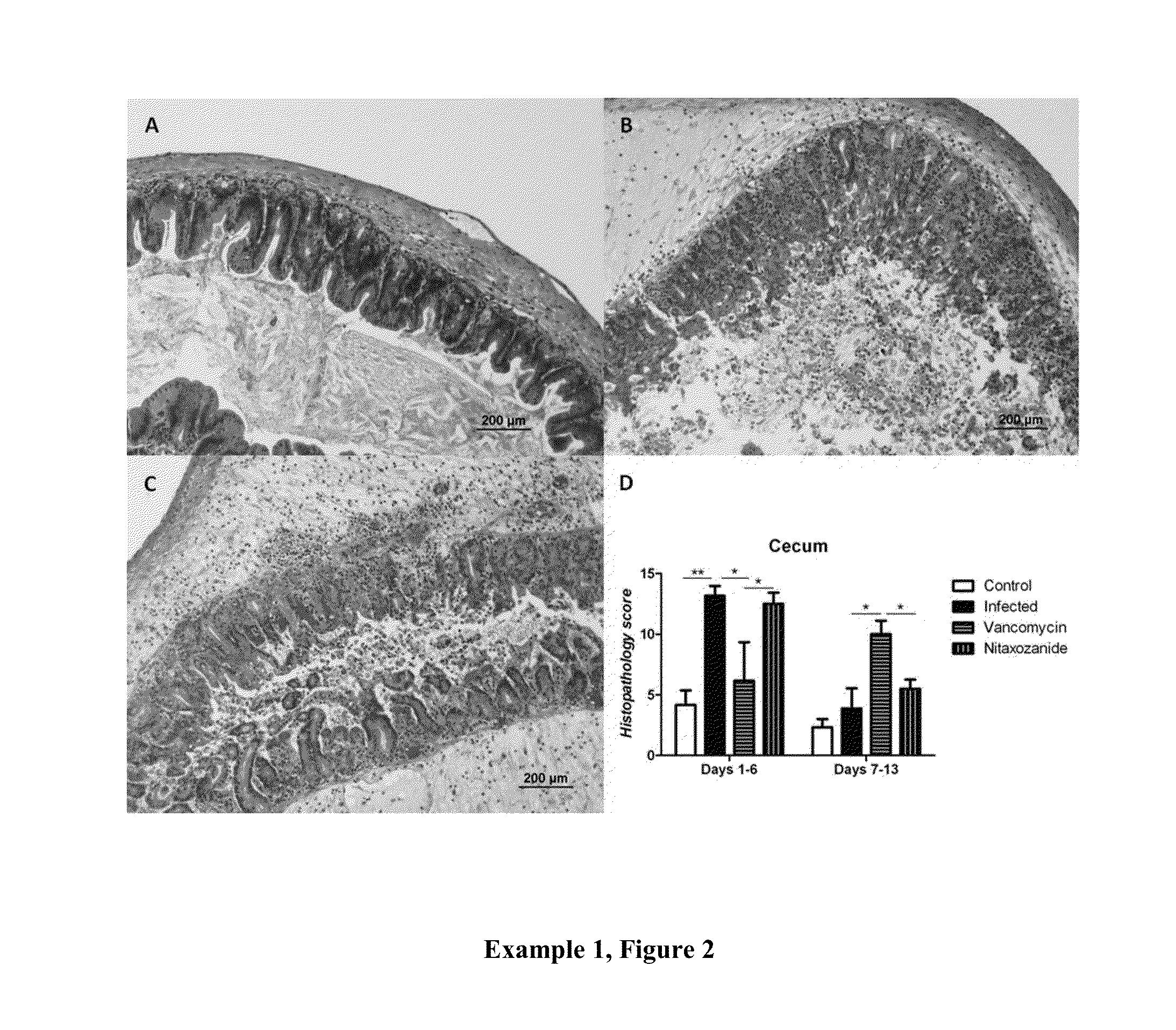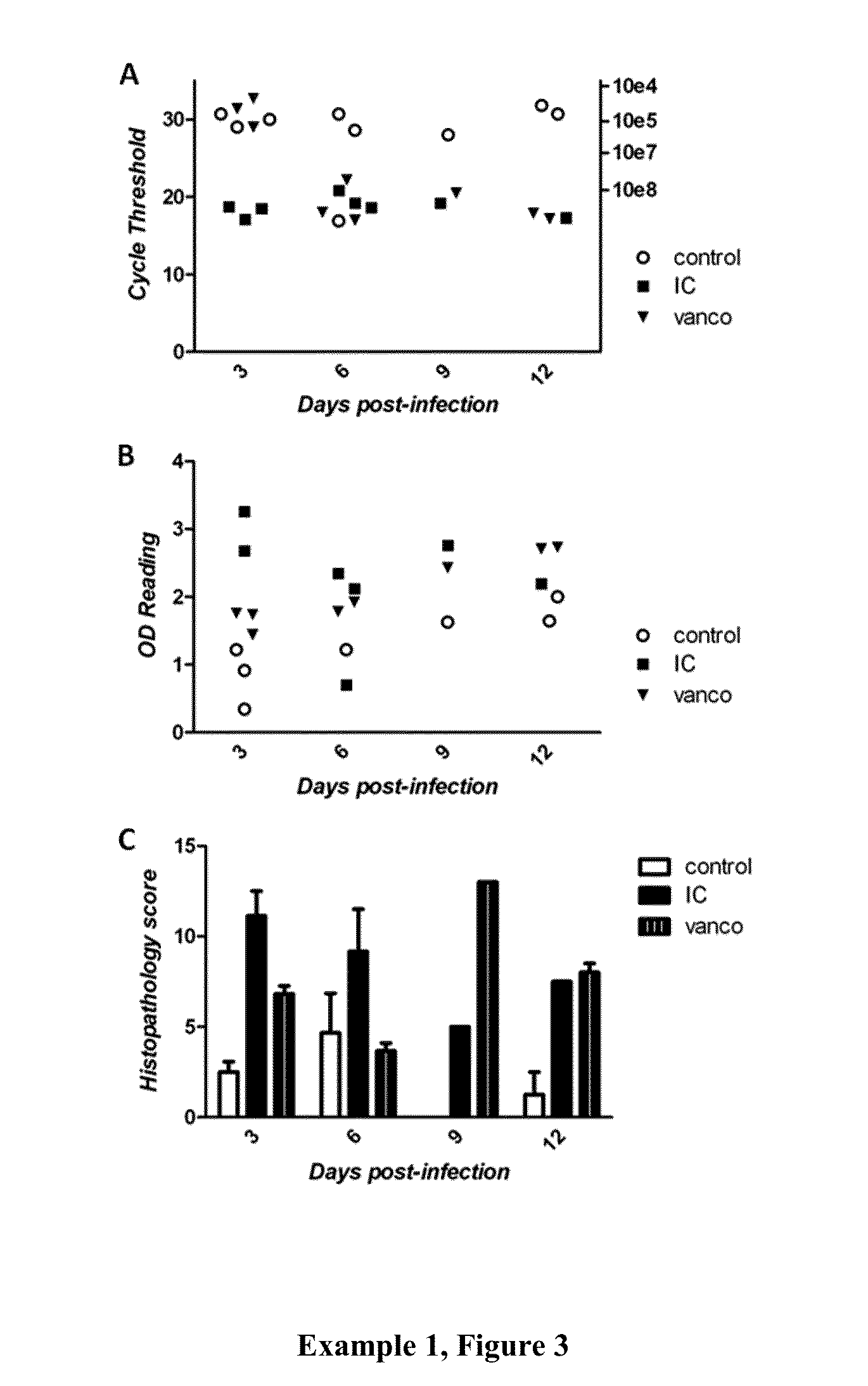Compositions and methods for treating clostridium infection and preventing recurrence of infection
a technology of clostridium infection and compositions, applied in the direction of biocide, peptide/protein ingredients, saccharide peptide ingredients, etc., can solve the problems of less evidence of alternative therapies and difficult treatment of recurrent diseases, and achieve the effects of preventing recurrent diseases, reducing igg production, and preventing recurren
- Summary
- Abstract
- Description
- Claims
- Application Information
AI Technical Summary
Benefits of technology
Problems solved by technology
Method used
Image
Examples
example 3
[0191]Example 3, FIGS. 1 (A, B, and C) provide three measurements of the various doses of fidaxomicin used to treat C. difficile infection. FIG. 1A shows the effectiveness of low doses on survival. It can be seen when comparing survival curves that low doses significantly increased survival of 2 mg / kg group compared with either the vehicle control (p=0.0191) or the 20 mg / kg / day group (p=0.0190), but not with the vehicle control compared to the 20 mg / kg / day group. In summary a lower dosage of Fidaxomicin significantly increased survival from infection compared with the drug vehicle and reduced relapse compared with a higher dosage (20 mg / kg). FIG. 1B shows the effectiveness of low doses on weight, that is, a two-way ANOVA did not find significant differences in weight across the course of the experiment; however you can see where infection starts to take hold or relapse occurs with weight drops in each group. FIG. 1C shows the effectiveness of low doses on clinical scores, that is, a...
example 1
[0197]1. Cohen S H, Gerding D N, Johnson S, Kelly C P, Loo V G, McDonald L C, Pepin J, Wilcox M H. 2010. Clinical practice guidelines for Clostridium difficile infection in adults: 2010 update by the Society for Healthcare Epidemiology of America (SHEA) and the Infectious Diseases Society of America (IDSA). Infect. Control Hosp. Epidemiol. 31:431-455. doi:10.1086 / 651706.[0198]2. Surawicz C M, Alexander J. 2011. Treatment of refractory and recurrent Clostridium difficile infection. Nat. Rev. Gastroenterol. Hepatol. 8:330-339. doi:10.1038 / nrgastro.2011.59.[0199]3. Pepin J, Alary M E, Valiquette L, Raiche E, Ruel J, Fulop K, Godin D, Bourassa C. 2005. Increasing risk of relapse after treatment of Clostridium difficile colitis in Quebec, Canada. Clin. Infect. Dis. 40:1591-1597. doi:10.1086 / 430315.[0200]4. Johnson S, Homann S R, Bettin K M, Quick J N, Clabots C R, Peterson L R, Gerding D N. 1992. Treatment of asymptomatic Clostridium difficile carriers (fecal excretors) with vancomycin o...
example 2
[0227]1: Li Y, Figler R A, Kolling G, Bracken T C, Rieger J, Stevenson R W, Linden J, Guerrant R L, Warren C A. Adenosine A2A receptor activation reduces recurrence and mortality from Clostridium difficile infection in mice following vancomycin treatment. BMC Infect Dis. 2012 Dec. 10; 12:342. doi: 10.1186 / 1471-2334-12-342.
PUM
| Property | Measurement | Unit |
|---|---|---|
| time | aaaaa | aaaaa |
| pH | aaaaa | aaaaa |
| mole fraction | aaaaa | aaaaa |
Abstract
Description
Claims
Application Information
 Login to View More
Login to View More - R&D
- Intellectual Property
- Life Sciences
- Materials
- Tech Scout
- Unparalleled Data Quality
- Higher Quality Content
- 60% Fewer Hallucinations
Browse by: Latest US Patents, China's latest patents, Technical Efficacy Thesaurus, Application Domain, Technology Topic, Popular Technical Reports.
© 2025 PatSnap. All rights reserved.Legal|Privacy policy|Modern Slavery Act Transparency Statement|Sitemap|About US| Contact US: help@patsnap.com



